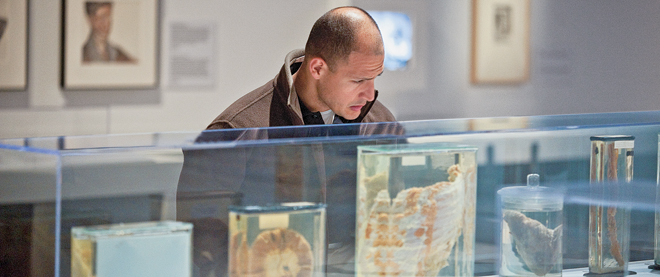The stuff of war, raw and uncensored
The War Museum’s new exhibit on medicine blends history, emotion and gore
Share

One of the first images confronted by a visitor to the Canadian War Museum’s War and Medicine exhibit is a photograph of a young American veteran of the Iraq war, shirtless, his back to the camera while his mother, a woman with grey hair and large eyes, embraces him. About one-third of the soldier’s head is missing. “There’s this mother who’s going to be caring for her son, who’s in his late 20s, for the rest of her life,” says Tim Cook, co-curator of the exhibition. “This show is not just about battlefield trauma. It’s about the long-lasting impact of war. It’s about hurting and healing and caring.”
A balanced mix of emotion and material history, the show was developed by the Wellcome Collection in London, England, and the Deutsches Hygiene Museum in Dresden, Germany. But Cook and fellow curator Andrew Burtch have adapted it by adding 150 images and artifacts, some from the museum’s permanent collection, others unique and unlikely to have been widely seen before. There’s a ceramic pot for holding leeches—once widely used to “bleed” infected patients—from the Museum of Health Care in Kingston, Ont.; a small display on Norman Bethune, the Canadian doctor who pioneered mobile blood transfusion during the Spanish Civil War and died a hero in China; and a handwritten copy of the poem “In Flanders Fields,” sent by its author, Canadian doctor and soldier John McCrae, to an American friend. The letter is normally housed at McGill University’s Osler Library of the History of Medicine.
Other items are more gruesome. A section of the show titled “The Body” demonstrates the physical damage caused by war and its attendant diseases. There are models of blown-apart faces and syphilitic genitals, as well as other body parts: a punctured skull, a brain traversed by a bullet, a leg bone riddled with holes created when pus from an infection tried to force its way through. “We haven’t pulled any punches. This is the stuff of war,” says Cook.
Gory artifacts, however, are not the most memorable part of the show. What sticks with a visitor are the personal stories woven into the exhibition. A wooden board with the word “vigilance” written on it hangs on a wall. It was once part of a Canadian-run field hospital at the Kandahar airfield, where Cpl. James Hayward Arnal was pronounced dead in July 2008. Two years later his mother, Wendy Hayward, came to work at the Tim Hortons on base so she could serve her son’s fellow soldiers. Hospital staff gave her the lumber when they dismantled the hospital.
Elsewhere there is a uniform and backpack full of medical gear that once belonged to Master Cpl. Martin Rouleau, a combat medic who served in Afghanistan. Everything is as it was in the field. The number of IED attacks and firefights are tallied in ink on the back of his helmet. Dust spilled out of the pack when museum officials opened it.
The exhibition’s final section, “The Mind,” explores the psychological toll of war. What we now describe as post-traumatic stress was once known as shell shock. First World War soldiers suffering from it often shook and stammered; on display there’s an electroshock machine that was used on their throats and limbs in an effort to cure these symptoms. But their genitals were also electrocuted—“as punishment, pretty much,” says Cook, who is also the museum’s Great War historian.
Care is now more compassionate. The museum has a computer simulator of the type used to treat traumatized veterans, which recreates the sights and sounds of ambushes and bombings. By reliving an event, “You come to grips with it—what’s in your control and what’s not,” explains Burtch. “It’s called exposure therapy.”
But if the way we treat victims of war has changed, the damage it inflicts is likely timeless. A battlefield diary captures the emotions of a Canadian soldier in Afghanistan, three days after a friend’s death: “I have fallen into an amorphous state of mind. I do not feel anything, no joy, no pain. It is like I am in a fog. Tomorrow we leave for five to seven days in unknown territory. I hope I will have the strength to write.”